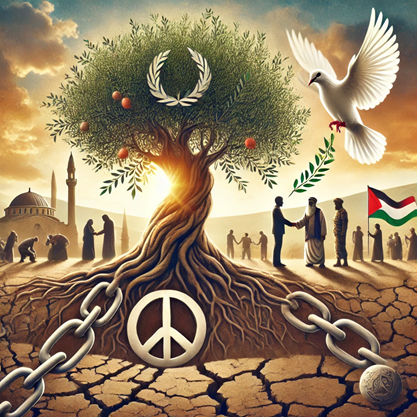Can peacebuilding efforts effectively address the root causes of long-standing conflicts?

Can peacebuilding efforts effectively address the root causes of long-standing conflicts?
by Sebastian 04:35pm Jan 02, 2025

Can peacebuilding efforts effectively address the root causes of long-standing conflicts?
Peacebuilding efforts have the potential to effectively address the root causes of long-standing conflicts, but their success depends on various factors, including the nature of the conflict, the involvement of local communities, the commitment of international actors, and the strategies employed. While peacebuilding can contribute to resolving underlying issues and preventing the recurrence of violence, it is a complex and long-term process that requires addressing both immediate and structural challenges. Here's a breakdown of how peacebuilding efforts can tackle the root causes of conflict, and the factors that influence their effectiveness:
1. Understanding the Root Causes of Long-Standing Conflicts
Root causes of long-standing conflicts are often multi-faceted and deeply entrenched. They typically include:
Historical Grievances: Many conflicts are rooted in long-standing historical disputes over territory, identity, or resources. These grievances may go back generations or even centuries, making reconciliation difficult.
Ethnic, Religious, and Political Divides: Ethnic and religious divisions can fuel conflict, especially when different groups feel marginalized, discriminated against, or oppressed. These divides often become politicized, creating deep mistrust and hostility between groups.
Economic Inequality and Poverty: Economic disparities, lack of development, and competition for resources can serve as underlying causes of conflict. When communities feel economically disenfranchised, they may resort to violence as a means of addressing their grievances.
Weak Governance and Corruption: Poor governance, lack of rule of law, and corruption can perpetuate instability and create environments where armed groups and militias can thrive. A lack of state legitimacy can fuel resistance to government authority, leading to protracted conflicts.
Competition for Resources: Disputes over natural resources like land, water, oil, and minerals often contribute to conflicts, particularly in resource-rich areas where access is contested or controlled by elites.
External Intervention and Influence: Foreign interventions, including colonial legacies, proxy wars, and the involvement of external powers, can exacerbate existing tensions and prolong conflict.
2. Peacebuilding’s Potential to Address Root Causes
a. Addressing Historical Grievances and Reconciliation
Truth and Reconciliation Commissions: Peacebuilding efforts often include mechanisms such as truth and reconciliation commissions, which aim to uncover past atrocities, offer apologies, and provide a platform for victims and perpetrators to share their experiences. The goal is to foster healing and promote forgiveness, which can help address historical grievances. For instance, South Africa’s Truth and Reconciliation Commission (TRC) after the end of apartheid played a significant role in acknowledging past injustices and building a foundation for national unity.
Memory and Narratives: Peacebuilding initiatives also focus on changing narratives about the past, challenging harmful stereotypes, and promoting inclusive national histories. Overcoming divisive historical narratives and creating a shared understanding of the past can reduce intergroup hostility and lay the groundwork for peaceful coexistence.
b. Building Inclusive Governance and Institutions
Power Sharing and Political Inclusion: Effective peacebuilding often involves creating inclusive political systems that provide representation for marginalized groups. Power-sharing agreements can ensure that all ethnic, religious, or political groups have a voice in the governance process, helping to reduce tensions and prevent exclusionary policies. The 1998 Good Friday Agreement in Northern Ireland, which established power-sharing between Protestants and Catholics, is a notable example of how political inclusion can help end decades of conflict.
Strengthening Rule of Law and Institutions: Peacebuilding efforts aim to rebuild or strengthen weak institutions, ensuring the rule of law and accountability. This includes reforming judicial systems, police forces, and security sectors to ensure they operate impartially and serve the needs of all citizens.This is crucial for addressing corruption and creating trust in government institutions, which are often sources of grievance in conflict zones.
Social Contracts:In post-conflict societies, peacebuilding processes can focus on forging new social contracts between the state and citizens. This involves commitments to human rights, equality, and economic justice that can help address systemic issues of inequality, marginalization, and exploitation.
c. Economic Reconstruction and Development
Addressing Economic Inequality: Long-standing conflicts are often driven or exacerbated by economic inequalities. Peacebuilding efforts that focus on rebuilding economies, creating job opportunities, and reducing poverty can help address one of the core drivers of conflict. For example, post-conflict reconstruction programs may prioritize infrastructure projects, microcredit schemes, and job creation programs that give disenfranchised populations the means to thrive.
Resource Sharing and Management: In conflict zones where disputes over resources are a major issue, peacebuilding efforts can focus on creating equitable systems for resource sharing. This can involve land reform, water-sharing agreements, and the management of natural resources in ways that prevent monopolies or exploitation by elite groups.
Investment in Education and Human Capital: Rebuilding education systems and providing opportunities for skill development are important aspects of peacebuilding. A well-educated population is less likely to fall into cycles of violence and more likely to engage in peaceful political processes. Moreover, education can help combat extremism by promoting tolerance, critical thinking, and social cohesion.
d. Promoting Social Cohesion and Healing
Community-Level Peacebuilding: Successful peacebuilding efforts often take place at the community level, where local actors work together to address division and promote healing. Grassroots initiatives can foster reconciliation between former adversaries, rebuild trust, and create spaces for dialogue. Community-based projects may include joint economic ventures, sports and cultural events, or collaborative work on local infrastructure.
Youth Engagement: Young people often bear the brunt of the consequences of conflict, and they can also be a key driver of change. Peacebuilding efforts that involve youth in decision-making processes, education, and community building can help to break the cycle of violence and build a more stable future.
3. Challenges to Addressing Root Causes through Peacebuilding
a. Deep-Rooted Historical and Identity-Based Conflicts
Difficulties in Overcoming Divisions: In conflicts driven by deep-seated ethnic, religious, or national identities, it can be extremely challenging to shift entrenched narratives and perceptions of the "other." In such cases, even well-intentioned peacebuilding efforts may fail to resolve the underlying divisions. The long-standing conflict between Israelis and Palestinians, for example, is rooted in complex historical, territorial, and identity-based grievances that are difficult to address through peacebuilding alone.
Trauma and Collective Memory: For communities that have experienced mass violence, trauma, and loss, the psychological scars can make it harder for individuals and groups to engage in reconciliation. The trauma of conflict can perpetuate cycles of violence and revenge, even when there are efforts to build peace.
b. Lack of Political Will and External Support
Weak or Corrupt Governments: In some post-conflict situations, governments may be weak or unwilling to engage in meaningful peacebuilding. Corruption, vested political interests, and a lack of commitment to democratic reforms can undermine peacebuilding efforts and perpetuate inequality. Without genuine political will, even the most comprehensive peacebuilding initiatives are unlikely to succeed.
International Intervention and Influence: External actors may complicate peacebuilding efforts by pursuing their own interests, leading to the imposition of solutions that do not reflect the priorities of local communities. External interference can also prolong conflict if foreign powers are perceived as supporting one side over another or if peacebuilding efforts are insufficiently coordinated.
c. Fragmentation of Armed Groups and Ongoing Violence
Intractable Armed Groups: In conflicts where multiple armed groups are involved, some factions may resist peacebuilding efforts. These groups may have their own political or ideological agendas that are incompatible with peace or reconciliation. Disarming such groups and incorporating them into the political process can be a daunting task, as seen in Colombia’s long-running civil conflict, where guerrilla groups resisted negotiations.
Spoilers and Violent Extremism: Even when formal peace agreements are reached, the presence of "spoilers" (individuals or groups that oppose peace) can derail progress. Violent extremist groups, criminal organizations, or rogue elements within the military can perpetuate violence and disrupt efforts at peacebuilding.
4. Conclusion: Can Peacebuilding Effectively Address Root Causes?
Peacebuilding efforts can effectively address the root causes of long-standing conflicts, but they are rarely a quick fix. Success requires long-term commitment, a comprehensive approach, and local ownership. In order to resolve deep-seated conflicts, peacebuilding must address not only the immediate triggers of violence but also the underlying structural, economic, political, and social issues that fuel conflict. This includes fostering inclusive governance, promoting economic development, healing historical wounds, and ensuring justice for all parties.
However, peacebuilding is often thwarted by the complexities of the conflict, the lack of political will, the persistence of extremist factions, and external interference. Even with the right strategies, the path to lasting peace is fraught with challenges. For peacebuilding efforts to be truly transformative, they must be adaptable, patient, and focused on long-term reconciliation and structural change rather than simply short-term ceasefires or agreements. Ultimately, while peacebuilding holds the potential for resolving the root causes of conflict, its success depends on the commitment and cooperation of all stakeholders, including local communities, governments, and the international community.






